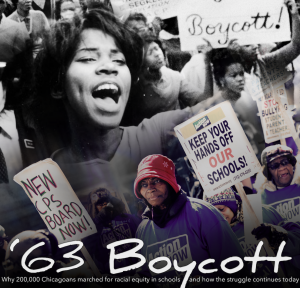During Fair Use/Fair Dealing week, we’re celebrating filmmakers. Ever since they developed a Documentary Filmmakers’ Statement of Best Practices in Fair Use, filmmakers have been improving the creativity and clarity of their work with it. Several recent hit films depended on it.
Blood in Baltimore.
Charm City, a festival favorite headed to public TV’s Independent Lens in April, follows neighbourhood folks, a police officer, and non-profit advocates as they all face epidemic violence in Baltimore. An intimate cinéma vérité portrait of a town in crisis by Marilyn Ness, it challenges viewers’ cynicism and preconceptions.
Executive producer Katy Chevigny noted:
With Charm City, we wanted to employ fair use because we were telling a story about the increased street violence and homicide rate in Baltimore and we wanted to include multiple news accounts of the increasingly dire situation, to set the stage for how our characters were reacting to the public awareness of the street violence.
We also chose to pay the rights holder for the rights to a song that we could have used simply with fair use. The reason we chose to clear it is because we wanted to use the song as score for the film, not just as part of the natural sound in the street as it was when we recorded it. We pulled the audio of the man singing “A Change is Gonna Come” under another scene for maximum impact.
We chose to clear it for artistic reasons; in order to use the song in this specific way, taken partly out of sync with the visuals. We worked with a music supervisor to clear these particular rights.
Dark money and elections.

Protesters against dark money in politics, from Dark Money.
Chevigny’s production company, Big Mouth Productions, also produced Dark Money, by Kimberly Reed. The film focuses on Montana to vividly demonstrate the struggle between deep pocketed, hidden funding and those fighting for democratic electoral process. The film will be on public TV’s POV in October. There too, fair use was important, she said:
In Dark Money, we also used archival video footage and radio footage from a variety of news sources. We chose to employ fair use to indicate that we were commenting on how the American public was learning about the complexity of money in politics through news reports from all over the country. We also employed fair use to show that it was a growing concern for Americans and was being reported on more frequently in recent years.
Finally, we employed fair use in a couple of instances when, after due diligence, we weren’t able to contact the rights holder of an obscure piece of footage. We did credit the original source to the best of our knowledge.
After 55 years…

Gordon Quinn’s ’63 Boycott employed fair use to retell a historic strike against school segregation in Chicago.
At Kartemquin Films, Gordon Quinn cited the importance of fair use in his recent Academy-Award-short-listed film ’63 Boycott, about a 250,000-student walkout in 1963 Chicago over racial segregation. Quinn had himself shot a lot of the original footage of the strike. But he employed fair use:
…to put the story in historical context. When one of our characters talks about what they were seeing on TV, for instance, we cut to news footage of the Southern civil rights movement. We have newspaper clippings and headlines that illustrate what people are talking about. Many of the stills we got from photographers we knew and used with permission, but a few we claimed fair use on. We also got things from archives that illustrate the argument we are making and claimed fair use.
In one case, he said, fair use was crucial:
We had a problem, because we did not have any images from 1963 of one of our characters, Rosie. We suspected that the Chicago Tribune archive would have them, but they would not let us in to search.
Then we got lucky. We had some footage of Bernie Sanders being arrested, which we shot at the demonstration at 73red and Lowe. But it was shot from an angle and we couldn’t verify that it was Bernie. So we posted the Bernie footage and it went viral. Then the Trib did an online story about our footage and posted their own stills from the event–with great images of Rosie! So we were able to copy them off the web and assert fair use.
Minding the Gap.

Keire in Minding the Gap.
Another Kartemquin Film, Bing Liu’s celebrated and beloved Minding the Gap, also employed fair use. At one point, the film’s central characters are looking at a video on the phone and we overhear the audio. The filmmakers didn’t need to get clearance; they understood that fair use covered incidental references (within limitations specified in the Doc Filmmakers Statement).
Got a good fair use story? Share it with us at https://cmsimpact.org/about-us/contact/.
Want to learn more about fair use? Read Reclaiming Fair Use: How to Put Balance Back in Copyright, 2d ed, loaded with stories about filmmakers and their achievements.

